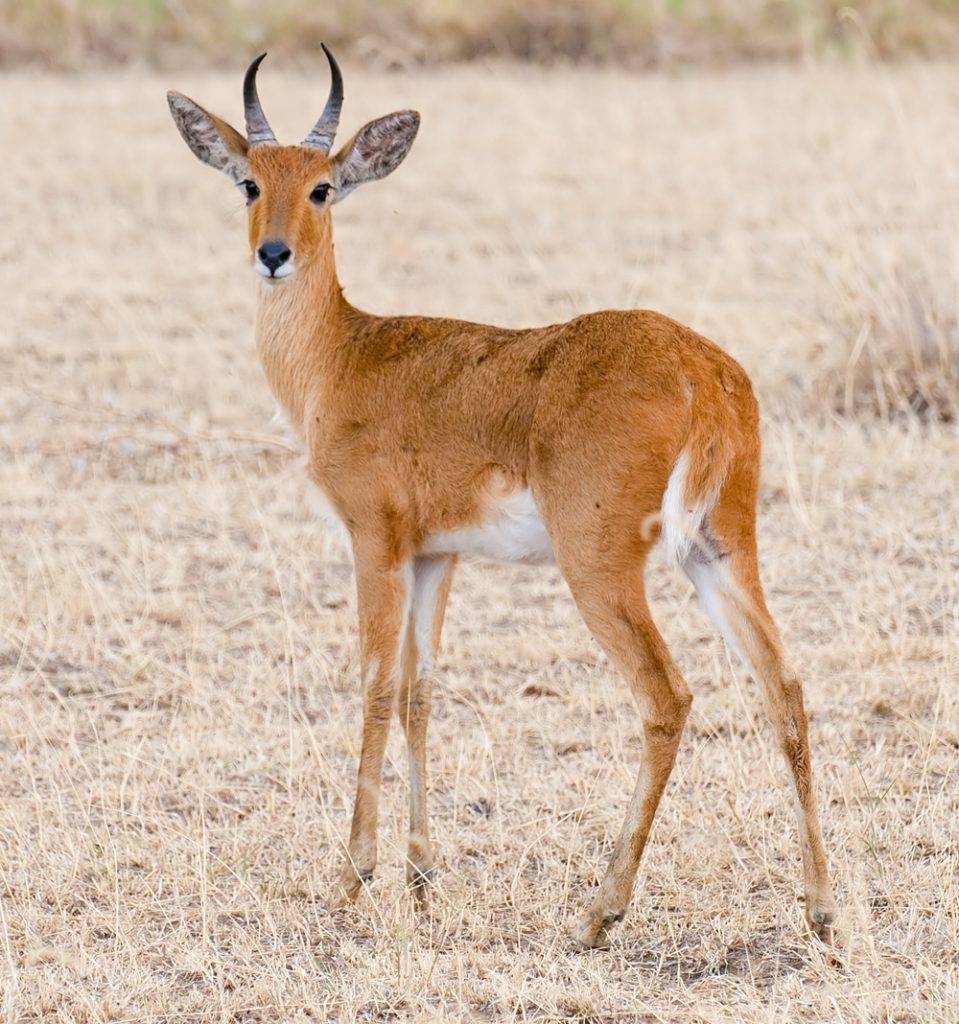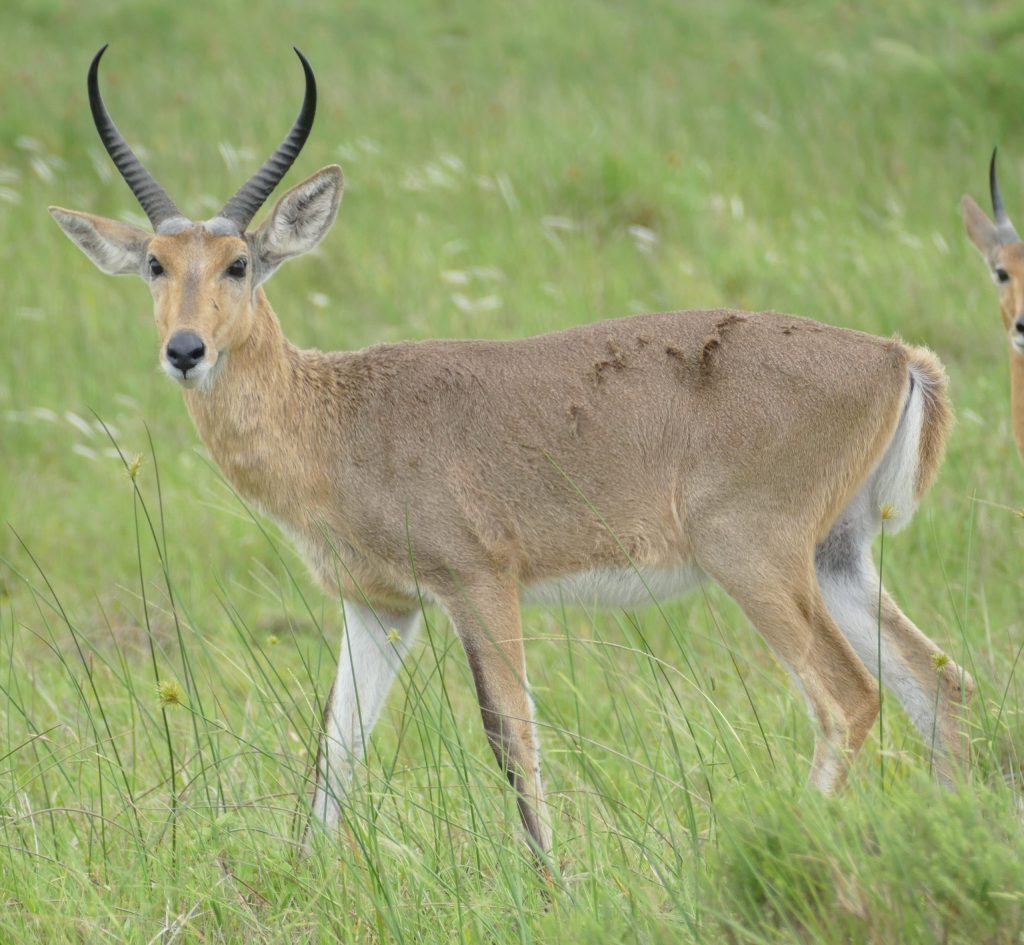Mountain reedbuck, Facts, Size, Classification, Habitat, Diet and More
Mountain reedbuck, small antelope on big hills
Late afternoon warms the rock. A shape appears on a slope, still as a cairn, then turns its head and the ears give it away. The mountain reedbuck stands a step above the skyline, hocks tucked, tail twitching, reading the wind in a way you feel more than see. One light whistle, and two more bodies rise from grass the color of old straw. The hill is not empty. You were slow to notice.
You let the engine die and the sound falls out of the air. The ram holds the contour path, horns swept back like small crescents, pale eye stripe sharp in the side light. He does not waste motion. A few measured steps, a look over the shoulder, and the group drifts toward a seam of stone as neat as a footpath in the sky.
Nothing here shouts. The mountain reedbuck trades in small decisions, a pause that says safe, a whistle that says move, and a quick bounce over rock that looks easy until you try the same ground on foot.
Identification, quick cues you can trust
- Slender antelope, grey buff coat with pale underparts and a white tail flash
- Males carry short, ridged, backward-curving horns shaped like open hooks
- Distinct pale eyebrow line and lighter throat patch
- High hock stance, hindquarters set for uphill movement
- Often seen motionless on rocky slopes before a quick, springy run
Fast reference table
| Feature | Detail |
| Scientific name | Redunca fulvorufula |
| Size | 65–75 cm at shoulder, 20–30 kg |
| Social | Small breeding groups, one adult male with females and young, or bachelor males |
| Habitat | Rocky hills, montane grasslands, escarpments near short grass and scattered bush |
| Range highlights | South Africa, Lesotho, Eswatini, Zimbabwe highlands, Malawi uplands, Ethiopia and Kenya escarpments for Chanler’s form |
| IUCN status | Endangered in many areas due to habitat loss and hunting pressure |
Recommended Safaris
5-Day Kahuzi Biega Congo Gorilla Trekking & Chimp Safari in Rwanda
$ 2500
per personBehavior you can read from a ridge
Reedbuck live by line of sight and early warnings. A ram posts higher, the group feeds lower. Roles swap every few minutes. The alarm is a thin, piercing whistle that lifts the hair on your arms before your brain tags the source. When they move, it is a fast, uphill canter with quick side steps that make cats misjudge. They stop on a shelf, look back, and melt into grass again.
Social time is quiet. Grooming flicks, short rests on sun-warmed rock, and small shifts to find better wind. Youngsters learn by shadowing, copying the pause, the listen, the dart. At last light they edge toward greener pockets, often where seep lines keep blades soft after the sun has baked the slope.
Diet
Grass first, especially short, sweet growth along seeps, fire scars, and south-facing slopes. In the dry, they pick seed heads and tougher blades, moving more to find small green islands. They drink when near water but pull much moisture from plants, which lets them hold high ground longer than you expect.
Reproduction
Breeding peaks follow local rains. After about seven months, a single fawn arrives in cover. The mother parks it for long stretches, feeding within earshot, returning for short nursing bouts. As the fawn grows, it joins the group for longer periods, practicing the classic freeze before the quick uphill sprint. Young males drift into bachelor units and test edges until a territory opens.
Where to see mountain reedbuck
- South Africa. Drakensberg and foothills, high granite domes in Greater Kruger fringes, Eastern Cape mountains
- Lesotho and Eswatini. Montane grasslands and rocky escarpments
- Zimbabwe and Malawi. Upland hills with short grass and scattered bush
- East Africa (Chanler’s). Kenya’s Laikipia escarpments and central highlands, Ethiopia’s high country
Work ridges at first and last light. Park below the skyline, glass the upper third of slopes, and let your eyes find ear flicks and tail flashes before whole bodies appear.
Mountain Redbuck Gallery
Field tips you can use today
- Kill the engine early and scan slowly with binoculars, left to right, top to bottom
- Look for a pale eyebrow and the white tail flag when animals change position
- Hold distance; if the ram keeps checking you, you are too close for a relaxed view
- For photos, start near 1/1000 at f/5.6–f/8, then wait for a side profile on a rock shelf
- Wind on your face helps; sound and scent carry oddly along stone corridors
Ethics
- Do not climb toward resting groups, pressure pushes them onto risky ledges
- Keep stops short where females hide fawns after rain
- Stay on tracks to protect thin montane soils and rare plants between rocks
Recommended Safaris
11 days Uganda Premium Gorilla, Wildlife & River Nile Adventure
$ 2900
per person4 Days Rwanda Gorilla Tour and Golden Monkey Trekking
$ 2500
per personTop 8 FAQs
Where are your best odds of seeing mountain reedbuck on a first trip?
Drakensberg foothills and Eastern Cape mountains in South Africa, Laikipia escarpments in Kenya for Chanler’s, and Zimbabwe uplands. Scan the top third of slopes at dawn and dusk.
What time of day works best?
First and last light. Cool hours bring feeding and ridge-top posts. Midday still pays on overcast days when animals sun on rock ledges.
How do you tell mountain reedbuck from common reedbuck?
Mountain reedbuck are smaller, greyer, with backward-curving hooked horns on males and a crisp pale eyebrow. Common reedbuck are larger, warmer tan, with thicker, forward-curving horns and prefer wetter lowlands.
Are they shy around vehicles?
Cautious. They trust height more than distance. Hold a steady angle well below the skyline and they will let you watch. Push the ridge and you will only see white tails.
What predators hunt them?
Leopard and caracal in rocky hills, wild dogs and hyenas where ranges overlap. The reedbuck answer is early detection, whistles, and uphill lines that force predators to spend energy.
Do they migrate or stay local?
Local movers. They rotate among favorite slopes, seeps, and fire scars within a compact home range, tracking green bite-sized growth through the season.
When do they breed and how many young do they have?
Peaks follow rains. A single fawn after roughly seven months is typical. Fawns hide for days at a time before joining the group for longer feeds.
Any simple photo advice for ridge animals?
Expose for the face, not the bright sky. Get low to place the animal against rock, not empty air. Wait for the profile with both horns clear and a forefoot raised for that light, uphill feel.
Conclusion
You learn to slow your eyes here. The mountain reedbuck will not rush your day. It offers a clean line on stone, a small whistle, a quick step that makes gravity look optional for a second. Share your dates and route. I will mark ridge pulls, safe turnouts, and two calm light windows that give this quiet antelope the room it needs while you get the view you came for.
Don’t wait,
book this adventure safari today
Low season
Oct, Nov, Mar, Apr, may
Peak season
Jun, July, Aug, Sept, Dec

Got any questions
about traveling to Uganda?
Get in touch.









